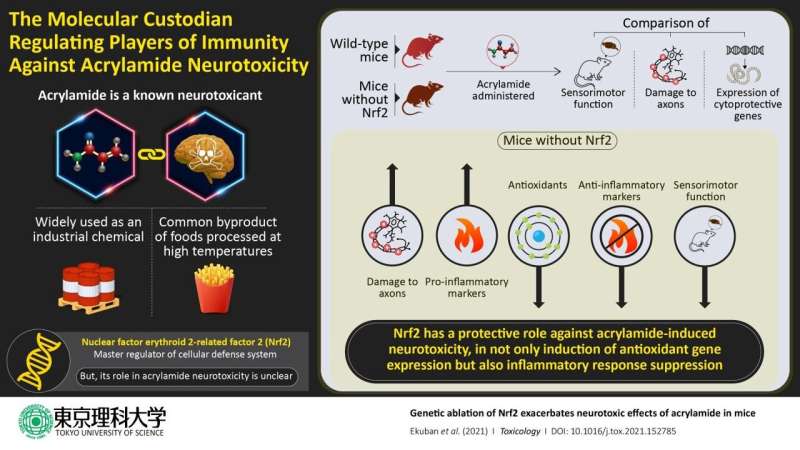Nrf2: The custodian regulating oxidative stress and immunity against acrylamide toxicity


Acrylamide is a toxic chemical compound that affects the nervous system. It is widely used in industries such as paper production, plastics, and wastewater management, and is also a byproduct of commonl-used food processing methods, which makes human exposure to acrylamide inevitable. Therefore, many studies have focused on understanding the toxic effects of acrylamide and our body’s response to them. Generally, in response to toxicity, the body’s cells release protective factors and antioxidants to remedy the damage. This response is activated by various cellular machinery. One such activator is a protein called ‘nuclear factor erythroid 2-related factor 2’ (Nrf2), which is a master regulator of the response to oxidative stress and the immune system.
In a recent study, a team of scientists, led by Prof. Gaku Ichihara from Tokyo University of Science, reported the role of Nrf2 in acrylamide-induced neurotoxicity. Prof. Ichihara states, “Our study showed that Nrf2 has a protective role against neurologic damage and suggests it is through activation of antioxidant stress genes and suppression of proinflammatory cytokine genes.”
In their study published in the journal Toxicology, Prof. Gaku Ichihara, along with his colleagues Prof. Masayuki Yamamoto from Tohoku University, Prof. Ken Itoh from Hirosaki University, Associate Prof. Seiichiroh Ohsako from The University of Tokyo, and Prof. Sahoko Ichihara from Jichi Medical University, used mice models to study the role of Nrf2 in acrylamide-induced neurotoxicity. They tested their hypothesis that when Nrf2 gene is removed, the neurotoxic effects of acrylamide will be amplified. For this, they developed ‘knockout’ mice that could not produce Nrf2, and gave the Nrf2-knockout mice and a set of counterpart ‘wild-type’ mice that could produce Nrf2 different concentrations of acrylamide for 4 weeks. Then, they compared the neurotoxicity between both groups of mice using various sensory and motor tests, immunohistochemistry, and protein and gene expression analyses.
The scientists found that the Nrf2-knockout mice had severe neurotoxic effects such as sensory and motor system dysfunction and axonal damage. While these mice produced fewer antioxidants and protective factors in response to acrylamide, they also showed enhanced release of pro-inflammatory chemicals, called “cytokines,” in the brain, which can potentially cause additional damage. Additionally, as different doses were given to the mice, the scientists also determined that the neurotoxicity was dose-dependent.
Previous studies have established the role of Nrf2 as a master regulator of protective genes but this study explained the specific mechanisms of immune response to acrylamide-induced toxicity, with Nrf2 at the center of it all. As Prof. Ichihara states, “The results document the first known morphological and neuro-functional evidence of the regulatory role of Nrf2 in acrylamide-induced neurotoxic effects in mice.”
The findings of this study are also immensely valuable in the field of disease biology, as recent studies have shown a link between air pollution and Alzheimer’s disease. Since the air contains other acrylamide-like chemical pollutants with similar neurotoxic effects, the study’s findings could prove useful in the prevention of Alzheimer’s disease.
Source: Read Full Article




